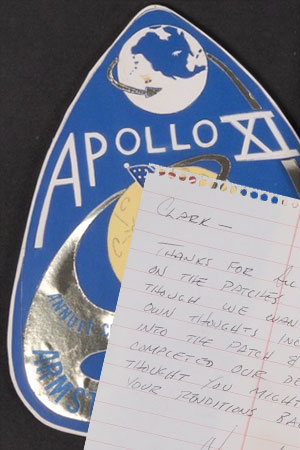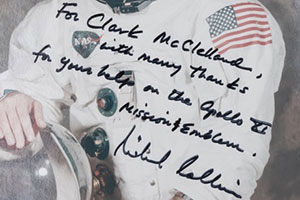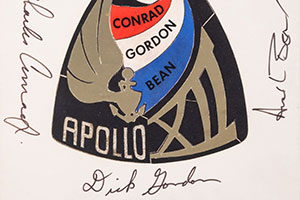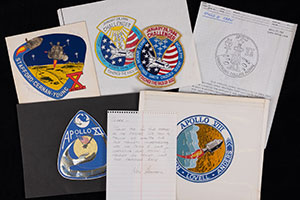February 3, 2025 — Neil Armstrong was appreciative, but as explained in his handwritten letter, it was too late. The Apollo 11 commander and his crewmates had already arrived at a design to represent the first moon landing.
Armstrong's note and the mission patch proposal that inspired it are up for auction in Goldberg Coins & Collectibles' Feb. 27 public sale in Los Angeles. The emblem art and first moonwalker's reply are part of the Clark C. McClelland collection, an archive of astronaut autographs, scale rocket models and flown memorabilia from the estate of a NASA engineer who died in 2021.
"My father worked on hundreds of manned and unmanned U.S. missions during his 34 years with NASA at Cape Canaveral in Florida," said Carrie Lane, one of McClelland's daughters, in a statement released by Goldberg.
Though other items from the collection are estimated to sell for more, McClelland's attempts to help with designing an Apollo mission patch may be the most unique pieces in the sale. Goldberg has grouped the majority of the concepts into one lot, which they have appraised at $700 to $1200.
"McClelland had a bit of an artist in him and submitted logo ideas to the various mission crews of Apollo and later the shuttle program," the auction catalog description for Lot 1017 reads. "McClelland submitted the most designs for Apollo 11 and Apollo 12, well over a dozen each."
There are also designs for Apollo 8, the first mission to send humans around the moon, Apollo 9 and the mid-flight explosion-plagued Apollo 13, as well as concept logos for rockets from when McClelland worked at the Martin Company (later Martin-Marietta and today Lockheed Martin).
One of McClelland's pencil drawings for Apollo 11 shows a circular patch with the astronaut symbol at its center flagged by the Mercury and Gemini program logos.
"This emblem shows recognition of each step [of the] national space program that has led to the Apollo 11's landing landing," McClelland wrote to the Apollo 11 crew in April 1969, three months before their launch.
Another full-color concept depicts an American flag planted on the moon at the center of a gumdrop-shaped emblem with the trajectory of the mission from Earth to the moon as the hand of god. The path itself appears to be filled with the lunar surface as seen from orbit and includes the Latin inscription, "Annuit Coeptis" ("Providence Favors Our Undertakings"), as borrowed from the Great Seal of the United States.
As Goldberg notes, McClelland's "designs were competing with so many others to win the favor of the various crews," and none of his Apollo ideas were accepted.
"We felt as though we wanted our own thoughts incorporated into the patch & have completed our design. I thought you might like your renditions back," wrote Armstrong before writing out his name (rather than adding his signature).
Separately, Armstrong inscribed one of his early NASA portraits to McClelland, "with appreciation for your ideas."
Similarly Apollo 11 command module pilot Michael Collins, who is credited with coming up with the eagle-centric concept for the Apollo 11 insignia, extended his thanks on an autograph photo for McClelland's "help on the Apollo XI mission & emblem."
Both Armstrong's and Collins' signed photos, together with a third inscribed "with many thanks" by Buzz Aldrin are included in the sale in another lot (1154), which is estimated to sell for $1,200 to $1,500.
The Apollo 11 astronauts collaborated with a different NASA employee, illustrator James Cooper, to develop Collins' drawings into a final design.
"We've been particularly pleased with the emblem of our flight, depicting the U.S. eagle bringing the universal symbol of peace from the Earth, from the planet Earth, to the moon that symbol being the olive branch," said Aldrin in a broadcast from space during the moon mission.
One additional lot (1165, $400 to $600) provides a look at one more unsuccessful attempt by McClelland to design an Apollo patch. His Apollo 12 concept design uses the same shape and some of the elements from one of his rejected Apollo 11 emblems, but incorporates naval wings as a nod to the "all Navy crew."
The border of the patch artwork was signed by the Apollo 12 astronauts, Charles Conrad, Alan Bean and Dick Gordon.
Though he never saw any of his designs launch to the moon, McClelland did design and had produced a commemorative patch in memory of the fallen STS-51L space shuttle Challenger crew. Lot 1017 includes his original color marker rendering and a embroidered example of the 1986 emblem.
In total, Goldberg Coins & Collectibles' auction has more than 200 lots with memorabilia from some of the nearly 40 space missions that McClelland worked. |
|

"Thanks for all your effort on the patches," wrote Neil Armstrong in reply to NASA engineer Clark McClelland's unsolicited proposals for the Apollo 11 moon mission emblem. (Goldberg/collectSPACE)

Apollo 11 astronauts Neil Armstrong, Mike Collins and Buzz Aldrin thanked Clark McClelland for his mission patch ideas. (Goldberg)

The Apollo 12 crew of Charles Conrad, Dick Gordon and Alan Bean autographed Clark McClelland's concept for their patch. (Goldberg)

The auction includes Clark McClelland's pencil and ink concepts for Apollo 8, 9, 10, 11, 12 and 13 mission patches. (Goldberg) |
